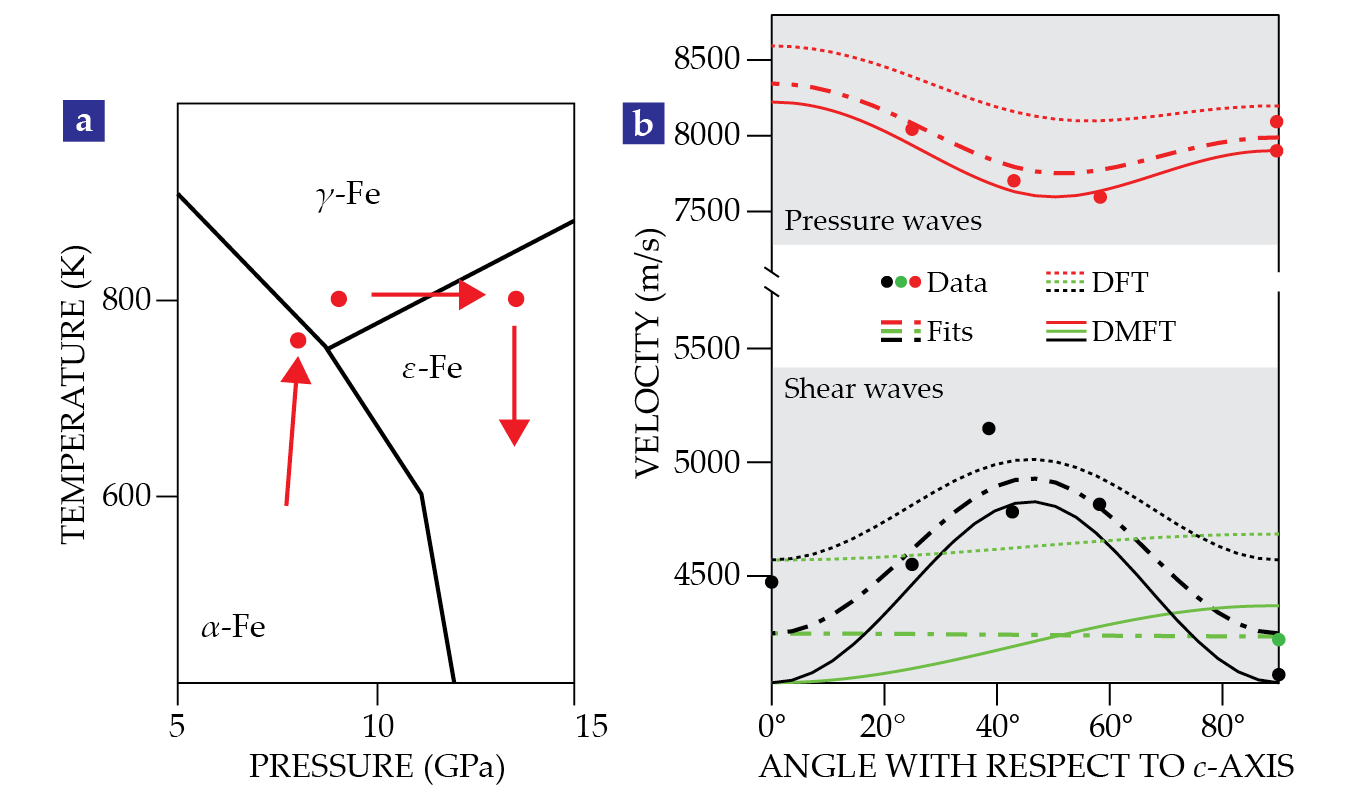A journey to Earth’s center, courtesy of an exotic iron crystal
DOI: 10.1063/PT.3.5320
No one has ever seen Earth’s core. Artists’ impressions such as the one in figure
Figure 1.

White hot solid iron—with a bit of nickel and some other elements—lies at the center of our planet. By re-creating its high-pressure crystal structure in the lab, researchers hope to better interpret the seismic measurements that are the source of most of what’s known about the inner core. (Image by Rost9/Shutterstock.com.)

But there’s a sticking point to the interpretation of seismic data: Laboratory researchers haven’t been able to measure the elastic properties of the hot, pressurized form of iron that makes up the inner core. Replicating inner-core pressures and temperatures, by themselves, isn’t such a problem. But as metalworkers have known for centuries (see the Quick Study by Lou Bloomfield, Physics Today, May 2007, page 88
Now Agnès Dewaele, of the French Alternative Energies and Atomic Energy Commission, and her colleagues have achieved a milestone in inner-core metallurgy. They’ve synthesized a single crystal of ε-Fe—the form of iron that’s stable under the extreme conditions of the inner core—that’s clean enough to measure its elastic constants. 1
The experiments don’t yet replicate the temperature, pressure, or impurity profile of the inner core, so they’re still several steps away from pinning down the sound speed through real inner-core material. But they provide a much-needed benchmark for theoretical models, and they pave the way for more experiments to get close to inner-core conditions.
Forged in fire
The inner core is mysterious in many ways. (See the article by Bruce Buffett, Physics Today, November 2013, page 37
The large-scale anisotropy doesn’t necessarily mean that inner-core iron is structurally anisotropic at the atomic scale. It could be explained, instead, by the large-scale distribution of materials with different impurity concentrations. But as it turns out, ε-Fe’s crystal structure is hexagonal close packed, which is in fact anisotropic: One of its crystal axes, the c-axis, is geometrically distinct from the other two.
Although the inner core probably isn’t one single crystal of ε-Fe, it could be made up of component crystals that are preferentially aligned. Deciphering what that alignment looks like—and how it might have arisen—could offer substantial insight into Earth’s geologic past. But it also requires an understanding of ε-Fe’s anisotropic elastic properties. And those measurements are hard to come by.
Pristine ε-Fe is extremely difficult to make in the lab. The naive approach—taking a single crystal of the ambient-pressure form of iron, α-Fe, and trying to compress it into ε-Fe—doesn’t work. The α-Fe crystal splinters into a myriad of tiny ε-Fe crystals too small to study individually. Worse, their crystal lattices are strained and distorted, so their properties probably differ considerably from those of unstrained ε-Fe.
Typical lab studies of ε-Fe, therefore, usually use polycrystalline samples made from compressing α-Fe powder. 2 That approach yields a lot of useful information. But it obscures the crucial distinction between the single crystal’s c-axis and the other two dimensions.
A different path
Dewaele came to the problem from a different direction. She was initially interested not in ε-Fe’s material properties but in the mechanisms of iron phase transformations.
3
In addition to α-Fe and ε-Fe, there’s also the γ-Fe phase, which iron adopts at high temperature, as shown in figure
Figure 2.

Single crystals of ε-Fe, the form of iron thought to exist in Earth’s inner core, can’t be made by directly squeezing the ambient-pressure phase α-Fe. (a) But they can be made by taking a detour through the high-pressure phase γ-Fe, as shown in the path in red. (b) Sound-speed measurements on ε-Fe single crystals clearly show the material’s elastic anisotropy, and they provide a valuable benchmark for theoretical models such as density functional theory (DFT) and dynamical mean field theory (DMFT). (Adapted from ref.

“We were using x-ray diffraction to monitor the fate of a single crystal,” she says, “when we noticed that the alpha–gamma transformation produced a completely different microstructure—and crystal quality—than alpha–epsilon.” Dewaele and colleagues soon worked out that by first heating the α-Fe into γ-Fe and then compressing it into ε-Fe, they could prevent most of the crystal splintering of the α–ε transformation. They still got polycrystalline ε-Fe, but some of the crystals were sufficiently large and unstrained to study. “We became very excited about measuring ε-Fe’s single-crystal elastic constants, which we knew was important and never done before,” she says.
Like most researchers studying static high pressures, Dewaele and colleagues squeezed their sample using a diamond anvil cell, which works by concentrating modest forces into a small volume. As a result, they were limited to speck-sized iron samples—just 60 µm across—and their “large” ε-Fe single crystals were a mere 20 µm across.
That might not seem like it would be big enough for measuring a crystal’s mechanical properties such as elasticity and speed of sound. But thanks to x-ray inelastic scattering, it is. When an x-ray photon passes through a crystal and excites a vibration, it loses energy and changes direction according to the vibration’s frequency and momentum. By analyzing the pattern of scattered x rays, researchers can determine the crystal’s quantized spectrum of vibrational modes, and from that, they can deduce its elastic properties and speed of sound.
Dewaele reached out to x-ray inelastic scattering expert Alexei Bosak, of the European Synchrotron Radiation Facility, to secure beam time and make the necessary measurements. The sound-speed results, shown in figure
The data points, so far, are sparse and scattered. But they show a clear trend of anisotropy: Shear waves are at their fastest, and pressure waves are at their slowest, at an angle of 50° to the c-axis. And the fits to the data provide a test for theoretical calculations, such as the density functional theory (DFT) and dynamical mean field theory (DMFT) results shown in the figure.
Smaller and larger
The experiments were performed at room temperature and pressures up to 33 GPa, a far cry from the 5600 K and 330–360 GPa of the inner core. The pressure difference, in particular, is significant. Applying that much pressure to a material, even a solid, squeezes its atoms more tightly together and boosts its sound speed by thousands of meters per second.
Diamond anvil cells can achieve inner-core pressures, but only for samples much smaller than the ones Dewaele and colleagues needed to create their 20 µm ε-Fe single crystals. But 20 µm isn’t a fundamental limitation; it’s a consequence of the constraints of their experimental system. As Dewaele explains, “If, in the future or on other platforms, inelastic x-ray scattering can be performed on smaller single crystals, then we can extend the measurements to higher pressures.” Indeed, the beamline they used at the European Synchrotron Radiation Facility is undergoing an upgrade to focus the x-ray beam to a smaller spot.
Pressure and temperature aren’t the only gaps that need to be bridged. The experiments, like the phase diagram in figure
Ultimately, the goal is to connect the small-scale elastic anisotropy of inner-core material to the known seismic anisotropy of the inner core as a whole to deduce the inner core’s internal structure: How big are its component iron–nickel crystals, and how are they arranged? From there, researchers hope to learn more about the geologic history of Earth’s depths and deep past.
But Dewaele is already wondering what other undiscovered single crystals might yet be synthesized through careful attention to phase-transformation mechanisms. “I am convinced that for many metallic systems, solid–solid transformations under high pressure can produce microstructures with outstanding properties,” she says. “One could call this metallurgy of the extremes.”
References
1. A. Dewaele et al., Phys. Rev. Lett. 131, 034101 (2023). https://doi.org/10.1103/PhysRevLett.131.034101
2. See, for example, E. Ohtani, Geophys. Res. Lett. 40, 5089 (2013). https://doi.org/10.1002/grl.50992
3. R. Fréville et al., Phys. Rev. B 107, 104105 (2023). https://doi.org/10.1103/PhysRevB.107.104105
